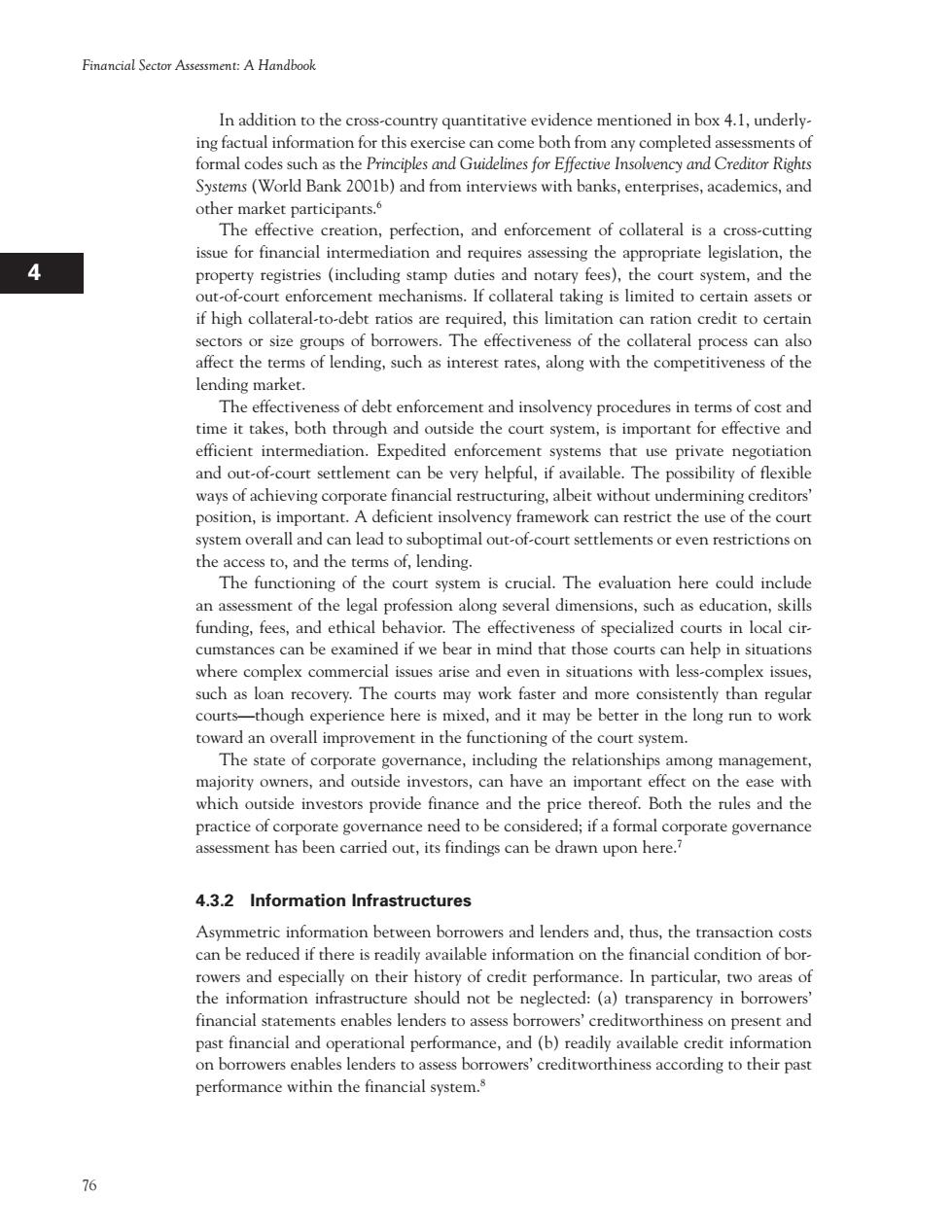正在加载图片...

Financial Sector Assessment A Handbook In addition to the cro country quantitative evidence mentioned in box 41,underly exerci Systems (World Bank 2001b)and from interviews with banks,enterprises,academics,and other market participants. The effective creation,perfection,and enforcement of collateral is a cross-cutting issue for financial intermediation and requires assessing the appropriate legislation,the 4 property registries (including stamp duties and notary fees),the court system,and the out-of-court enforcement mechanisms.If collateral taking is limited to certain assets or if high collateral-to-debt ratios are equired.this limitation or size gr effectiver sof collateral pr cess can ms of lending,such as interest rates,along with the competitiveness of the lending market. The effectiveness of debt enforcement and insolvency procedures in terms of cost and time it takes,both through and outside the court system,is important for effective and efficient intermediation.Expedited enforcement systems that use private negotiation and out-of-court settlement can be very helpful,if available.The possibility of flexible ways of achieving corporate financial restructuring,albeit without undermining creditors' Position,s A deficient insolvenc restrict the of the c system overalla and can lead to sub ptimal out-of-court settlements or even restrictions or the a sto,and the re ns of,lending The functioning of the court system is crucial.The evaluatior n here could include an assessment of the legal profession along several dimensions,such as education,skills funding,fees,and ethical behavior.The effectiveness of specialized courts in local cir- cumstances can be examined if we bear in mind that those courts can help in situations where complex commercial issues arise and even in situations with less-complex issues. such as loan recovery.The courts may work faster and more consistently than regulat courts-though experience here is mixed,and it may be better in the long run to vork ard an nt in the functioning of the cou The state of corporateg vemance,includi among managemen majority owners,and outside investors,can ct on the ease wi which outi invetor providefnancend the price tro o theuand he practice of corporate governance need to be considered;if a formal corporate governance assessment has been carried out,its findings can be drawn upon here. 4.3.2 Information Infrastructures Asymmetric information between borrowers and lenders and,thus,the transaction costs can be reduced if there is readily available information on the financial condition of bor- rowers and especially on their history of credit performance.In particular,two areas of the information infras should not be glected:(a)tr ency in bo financial sta ents enables lender rs to ss bo reditw h: pas t financial an opera ional performance,and (b readily available cr on borrowers e ables lenders to assess borrowers'creditworthiness according to their past performance within the financial system. 76 Financial Sector Assessment: A Handbook 1 I H G F E D C B A 12 11 10 9 8 7 6 5 4 3 2 In addition to the cross-country quantitative evidence mentioned in box 4.1, underlying factual information for this exercise can come both from any completed assessments of formal codes such as the Principles and Guidelines for Effective Insolvency and Creditor Rights Systems (World Bank 2001b) and from interviews with banks, enterprises, academics, and other market participants.6 The effective creation, perfection, and enforcement of collateral is a cross-cutting issue for financial intermediation and requires assessing the appropriate legislation, the property registries (including stamp duties and notary fees), the court system, and the out-of-court enforcement mechanisms. If collateral taking is limited to certain assets or if high collateral-to-debt ratios are required, this limitation can ration credit to certain sectors or size groups of borrowers. The effectiveness of the collateral process can also affect the terms of lending, such as interest rates, along with the competitiveness of the lending market. The effectiveness of debt enforcement and insolvency procedures in terms of cost and time it takes, both through and outside the court system, is important for effective and efficient intermediation. Expedited enforcement systems that use private negotiation and out-of-court settlement can be very helpful, if available. The possibility of flexible ways of achieving corporate financial restructuring, albeit without undermining creditors’ position, is important. A deficient insolvency framework can restrict the use of the court system overall and can lead to suboptimal out-of-court settlements or even restrictions on the access to, and the terms of, lending. The functioning of the court system is crucial. The evaluation here could include an assessment of the legal profession along several dimensions, such as education, skills funding, fees, and ethical behavior. The effectiveness of specialized courts in local circumstances can be examined if we bear in mind that those courts can help in situations where complex commercial issues arise and even in situations with less-complex issues, such as loan recovery. The courts may work faster and more consistently than regular courts—though experience here is mixed, and it may be better in the long run to work toward an overall improvement in the functioning of the court system. The state of corporate governance, including the relationships among management, majority owners, and outside investors, can have an important effect on the ease with which outside investors provide finance and the price thereof. Both the rules and the practice of corporate governance need to be considered; if a formal corporate governance assessment has been carried out, its findings can be drawn upon here.7 4.3.2 Information Infrastructures Asymmetric information between borrowers and lenders and, thus, the transaction costs can be reduced if there is readily available information on the financial condition of borrowers and especially on their history of credit performance. In particular, two areas of the information infrastructure should not be neglected: (a) transparency in borrowers’ financial statements enables lenders to assess borrowers’ creditworthiness on present and past financial and operational performance, and (b) readily available credit information on borrowers enables lenders to assess borrowers’ creditworthiness according to their past performance within the financial system.8